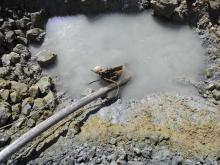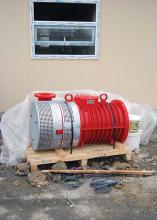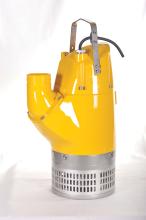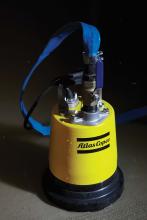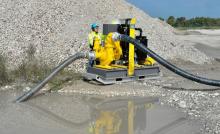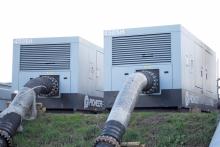
Excess water in quarries often needs be removed and operators can choose from various methods, including pumping. Patrick Smith reports.
Dewatering in quarries and mines that extend below groundwater level is said to be essential for a safe and efficient working environment.
A number of methods can be used to remove excess water and these include pumping, where the water is contained in sumps or pools and then pumped away for disposal.
Often engineers in quarries and mines, or in other industrial settings, are faced with the decision between using a diesel-powered pump unit, or an electric one, says Bill Noakes, marketing manager at Atlantic Pumps.
“Of recent times, pressures to increase efficiency and cost savings, and environmental and safety considerations, have led to the two options being looked at more and more seriously. There are a number of points that must be considered when making this decision and it is important to first carefully examine your application and pumping needs,” says Noakes.
For example, the location of the site may limit an operator to diesel.
“If electrical supply is insufficient for a large pump or too unreliable in remote areas, then diesel power is the logical conclusion. Also, the usage and location of the pump within your site may favour diesel power as electrical pumps are often less mobile.
“If, say, you have a number of locations around the site that need dewatering, it could be impractical to lay electrical cabling all over the site. Having said this, electric submersible pumps should be considered: they are very flexible and if you go for a model such as the Audex range, they are perfectly designed for the wear and tear of the mining and quarrying environment.”
Another consideration, says Noakes, is the electricity supply.
“For electrical systems the power source can affect their suitability. If a permanent power point is present the only efficiency check need be on the pump. However, if your site features a centralised or mobile generator to provide electrical power then the efficiency of the conversion of diesel to electricity almost entirely rules out the possibility.”
Environmental and safety considerations are vital, says Noakes, as is maintenance of the chosen pump solution.
The bottom line, says Noakes, is that electrical pumps carry huge savings if
heavily used in the same location and on-grid power is available, while diesel power is usually best for mobile pumping solutions and where electrical power has to be generated on site.
(A full version of this article can be found at www.aggbusiness.com).
Minimal environmental impact remains a primary concern for many contractors, and Selwood says it has a range of pumps that are engineered to meet this requirement.
As an example, quarrying company and concrete products supplier E&JW Glendinning needed expertise from a specialist pumping provider to help it solve a complex problem at its Pigsdon Quarry site at Bude, in county Cornwall, south-west England. It turned to Selwood.
The site is used for quarrying high PSV gritstone, an ideal material for road surfacing, and Glendinning works closely with the UK Environment Agency to ensure its activities at Pigsdon have as little impact on its surroundings as possible.
Pigsdon is in an area subject to high rainfall, and there is a need to safely handle a significant amount of surface run-off as well as some additional water discharged during the quarrying process.
The water is collected in lagoons created around the site, and because it contains high volumes of silt, it needs to be thoroughly filtered before it can be safely discharged into a nearby stream.
Glendinning had installed a capable filtration system, but its problem was in finding a pumping solution capable of flowing water into it at the high volumes required.
Reliability, ease-of-maintenance and minimal downtime were key requirements for the site, where monthly sampling checks are carried out, both upstream at the point of discharge into the local river and downstream, to ensure strict limits on PH value, aluminium levels and levels of suspended solids are adhered to.
Selwood’s specialists set to work to find the best and most efficient solution for the job.
Having considered a drainer pump, Selwood settled on an S100 solids handling pump, which it says is ideally suited to the application due to its ability to operate at volumes of up to 160m³/hour.
The S100, now on site at Pigsdon, joins two other Selwood pumps previously purchased by Glendinning. All three pumps are being supported by the company’s new depot in Saltash.
“The pump is in near constant operation with minimal maintenance required, ensuring that Glendinning can continue to quarry with peace of mind that their environmental obligations are being met,” says Selwood.
Meanwhile, BBA Pumps has been awarded its largest-ever order for PT pumps from the Dutch dewatering company Koop Watermanagement.
The company says that the largest part of the investment consists of 100 pieces of PT150 diesel-driven wellpoint dewatering pumps. These piston pumps are positive displacement pumps and fully self-priming, meaning they are capable of handling air, water or any mixture of both without requiring a separate priming system.
The pumps can run dry without causing damage or wear to any part of the unit.
Koop Watermanagement is a traditional family business specialising in groundwater control, and under the leadership of Frans Koop, the company has become increasingly active internationally and is now a major player in the European market.
“It’s not just about the clear logistical benefits or the DriveOn engine concept with its 1,500-hour service interval, it’s much more than this,” says Frans Koop.
“This pump just fits perfectly to our vision and business philosophy. The low fuel consumption and focus on environmentally friendly details are really important to us.”
“No user can afford to ignore the issue of operating costs: the longer and more intensively pumps are used, the more expensive the dewatering process,” says Tsurumi.
Tsurumi’s high performance level sensor switches the pump on and off again depending on the water level.
“It therefore only runs if required. Depending on the motor size and water volume, significant power costs and machine operating time can be saved,” says Tsurumi.
“Another benefit is that the pump can always lie in the pump sump ready for operation, like a quiet level monitor in case other measures have not been taken. Because even though a high volume of water appears unlikely, it cannot be completely ruled out.”
Tsurumi’s sensor works without any moving parts, and models such as the universal KTZE or the KTVE, which can also be installed permanently, are already equipped with the sensor.
Thompson Pump is offering its new RECON2000T control panel with enhanced functions using interactive technology that allows for remote pump control and monitoring, and reduces the time and labour needed on-site. The company says the panel allows owners to operate the pump and supervise performance from a smartphone, laptop, desktop computer or any other device with internet access.
The RECON2000T utilises cellular and satellite networks for a secure and reliable connection in even the most remote locations, and also comes Wi-Fi ready. It gives operators informational access and control over the pump unit with the ability to remotely monitor the unit, record data and vary speed. The dashboard displays all the same pump and engine data as it appears on the RECON2000T control panel on-site, and if there is a problem with the pump or engine, the RECON2000T can be set up to notify operators on their internet-activated device.
In another move,
The company says this has resulted in pumps that offer up to 20% overall reduction in power consumption compared to previous models combined with greater efficiency, simplified maintenance and increased capacity. The WEDA+ range comprises five models: the WEDA 50, with normal and high head variants, and the WEDA 60+, available in normal head, high head and super high head configuration. The latest pumps offer flow rate capabilities of 1,020-2,425litres/minute (61-46m³/hour) and a maximum head of up to 69m.
“The new WEDA+ pumps are easy-to-move and install in a wide range of dewatering applications,” says Wim Moors, vice-president pumps, Atlas Copco Portable Energy.


